_ Daniel Fiß, Okzident Media. 15 November 2021, Rostock.*
In terms of percentage, they are the strongest group of voters for the AfD: the workers. For some, it is the demoscopic constant with potential for expansion. For the others, it is too limited a voting space to scale the AfD to results of over 15 percent. We worked our way through several studies, statistics and publications, analysing the workers’ motives for choosing and trying to measure the socio-economic field of the AfD. This analytical note is an important contribution for everyone who wants to learn more about the motives and value attitudes of AfD voters.
Hardly any other topic divides the AfD’s substantive and programmatic drive as much as the question of the relationship to “the workers”. On this basis, different socio-economic questions are asked to determine the relevant target groups. Looking at the results and statistics of the last federal and state elections, it becomes clear that the AfD achieved the highest approval ratings within the working class. The internally competing camps of the AfD draw their different conclusions from these results. For some, the strong results among the workers are an indication of a “proletarianization” of the party, which in the end only scares off bourgeois-conservative voters. The others, in turn, see a growing potential among the workers to establish the AfD as a socially patriotic alternative in the long term. In both camps, however, one often experiences incorrect assumptions, wishful projections and wrong conclusions, as we will show in the course of this analytical note.
There is now a wealth of research literature and studies on the role of modern working-class milieus and their preference towards right-wing populist (understood in a positive sense) movements and parties, which, on an empirical basis, paints a differentiated picture of the relationship between workers and the AfD and other right-wing conservative populist parties. From Marxist and class-struggle interpretation patterns to the investigation of socio-cultural and mental value coordinates, different approaches come together, which rarely allow a uniform interpretation, but very well depict tendencies and social atmospheres.
The post-industrial age
To this day, the stereotypical images of “the workers” as soot-smeared mining buddies and steel mill workers persist in the imaginations of many political actors. In the sociological milieu differentiations between workers and employees, the classic distinction between manual and cognitive activity is usually made. In reality, these boundaries are becoming increasingly blurred and only play a role in isolated cases from the point of view of labour law (insurance relationships, wage rates, etc.).
Fig. 1. Employed persons by job position (1965-2018, in percent of total)

Source: Federal Office of Statistics.
Since 1960, the classic world of work has undergone a fundamental change from the industry-based economy to the dominance of the service economy, which also explains the growing number of salaried employees. While in Germany there were just under 12 million union members at the beginning of the 1990s, the number has shrunk to just under 6 million today. In the conventional Marxist reading, the working class was still seen as a unified socio-economic bloc with similar worlds of experience. However, this block was broken up more and more by changing employment histories, specialization requirements, globalization, and flexibility. New challenges such as certifications and lifelong learning and professional mobility are becoming increasingly important in the world of work. While it used to be customary to move to another company at most once in a lifetime after completing the training, nowadays changes between five or six different employers, including retraining and further education, are no longer uncommon.
In contrast, we see a steady rise in nominal wages and a relative stagnation in wage developments over the past 20 years, with at most slight increases in the real wage index. This fact already indicates a central misunderstanding in the dispute over the direction of the AfD, namely that the working-class environment is characterized by precarious working conditions, but not by low wages and poor incomes. The fact remains, however, that real wages continue to fall due to the rise in the price index, which means that while it is sufficient for the average worker to maintain a reasonable standard of living, the accumulation of savings becomes more and more difficult.
Fig. 2. Real wage index, nominal wage index and consumer index in Germany (1991-2019, base year = 2015)
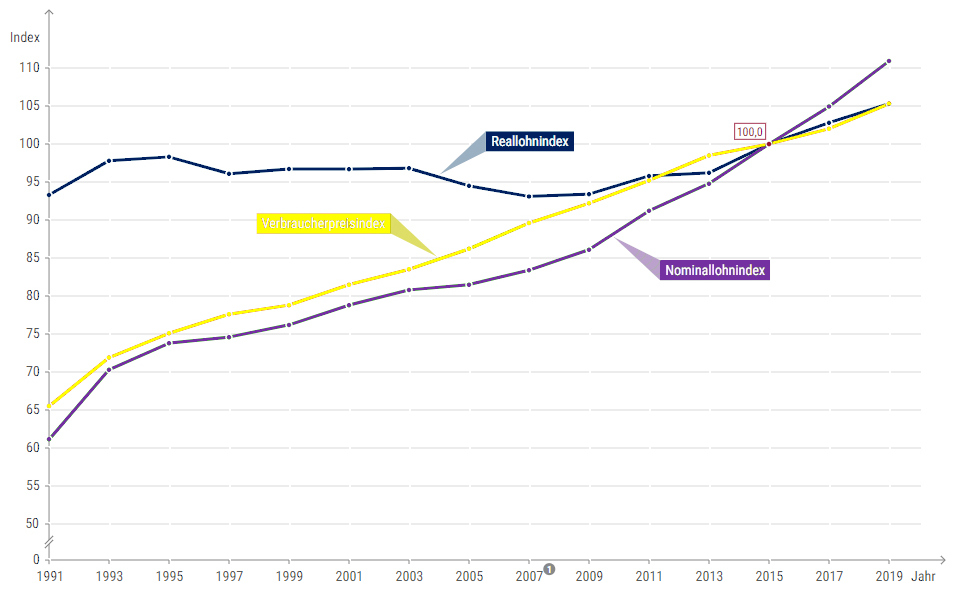
Source: Federal Office of Statistics.
The world of work has been torn up and can therefore hardly be viewed as a single political or social subject. The vision of many left parties to shape the working class into a unified subject with political power has been a story of failure across Europe for almost 20 years now. Numerous studies were written by left-wing and social democratic foundations,[1] all of which only came to the helpless conclusion that the social democratic parties no longer have the same binding force as they did in the 20th century. The reasons given are mostly neoliberal government experiments by social democratic parties and growing competition in the left. Many left thinkers do not get beyond their own Marxist thought barriers and imagine class-struggling subjects who in the post-industrial age no longer want to see themselves as a political community of struggle or community of will. With the rise of the AfD in Germany and the newly gained strength of right-wing populist parties in France, Austria and Italy, however, another aspect has arisen that explicitly deals with the cultural dimension.
Fig 3. Average share of votes for social democratic parties vs. “radical” right-wing parties in Europe (1999-2020, share of votes in parliamentary elections)

Source: Tarik Abou-Chadi T., Mitteregger R., Mudde C. (2021).
The Kulturkampf
In numerous studies, connections between economic status, socio-cultural value compass and a voting decision in favour of the AfD have already been examined. In almost all studies it becomes clear that it is less the concrete and real economic situation that favours a choice for the AfD, but more subjective horizons, biographical patterns, and mental structures.
Building on the Socio-Economic Panel 2016 (SOEP), the authors Holger Lengfeld and Clara Dilger already examined two empirical approaches in 2018 that explained sympathy for the AfD from economic and / or cultural threats.[2] The main link between both approaches remains the fundamental scepticism about immigration and the consequences of a multicultural society. In the economic dimension of the “modernization loser thesis”, increasing immigration is seen as a competition and threat to the labour market, social benefits, and the housing market. The cultural threat thesis, on the other hand, expresses a much deeper phenomenon that eludes the purely material aspect and opens the line of conflict between communitarian and cosmopolitan attitudes.
Basically, the “SOEP” contains variables that support the economically-oriented modernization loser thesis, but at the same time also makes it clear that the core of the AfD electorate does not mobilize itself through a single specific milieu. In the lower income classes with a low level of education, there is a higher affinity for AfD, but at the same time the party has more sympathy and approval among the self-employed and is overall more popular among the employed. With people with middle income and average schooling, the AfD can score as strongly as other parties. Lengfeld and Dilger therefore come to the conclusion:
“From this we conclude that the AfD is supported more often by those who have lost out on modernization, but also by some of the middle classes. In contrast, the variable on refugee immigration indicates a clear cultural split between AfD supporters and supporters of other parties “
In their study “Popular Elections – Mobilization and Counter-mobilization of Social Milieus”, Vehrkamp and Wegschaider consciously use the dichotomy between “modernization sceptics” and “modernization proponents”.[3] Their approach by categorizing the individual Sinus milieus provides a spatial, multidimensional representation of socio-economic classifications, cultural attitudes, and value matrices, with the help of which the spectrum of voters can be classified into different areas. For the AfD they see a particularly high ability to mobilize within the “precarious milieu”, but at the same time note that in absolute numbers the AfD electorate is distributed quite evenly across all economic groups and that the connecting elements run through the block of modernization scepticism. In particular, the cohesive cement and the AfD’s right to exist remain the rejection of immigration for most voters.
Fig. 4. Sinus milieus – distribution of all eligible voters
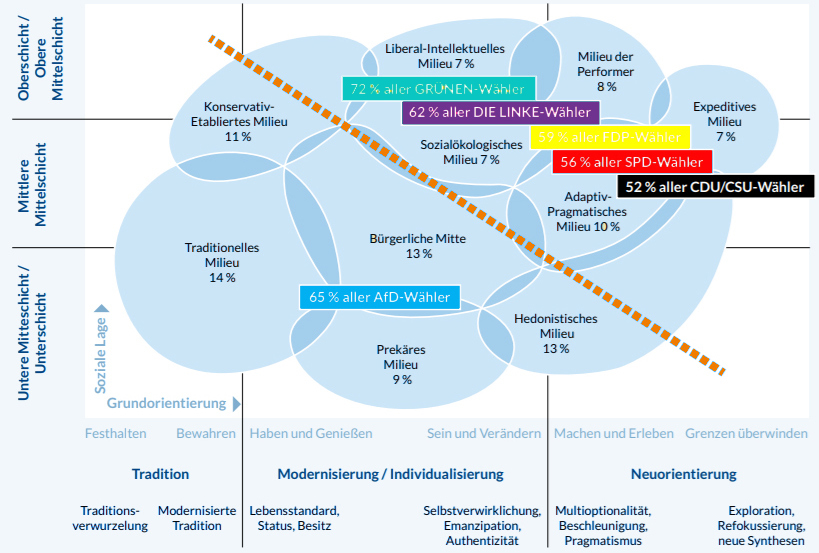
Source: Vehrkamp R., Wegschaider K. (2017).
The two authors see the quantitative distribution of the entire spectrum of voters within the modernization sceptic and supporter dichotomy in a close 50:50 ratio. Kohlrausch describes the abstract emotional structure of the sceptical side as follows:
“(…) that people who agree with the statements “I’m stuck in insecure cheap jobs”, “Digitalization is increasing control and monitoring at my workplace” and “My life is decided somewhere out there in the world”, in all of the salary groups are more likely to have fear of relegation. Fears of relegation are therefore also fed by the feeling of being at the mercy of the uncertainties that social changes such as digitization or globalization bring with them. Last but not least, they are an expression of the feeling of having lost control over the shaping of one’s own life. This fear runs through all salary groups – it is thus somewhat decoupled from the financial situation. Nevertheless, they have a real social connection, namely the concrete experiences that people have in the workplace.”
This makes it clear that the feeling of loss of control and the personal unavailability of life and one’s own social environment could be a major driving force behind the high levels of approval of the working class for the AfD. Self-control over employment history and career opportunities are being lost and job security, especially in the still-present industrial sectors, is coming under increasing pressure under increasing globalization dynamics. The growing overall prosperity of recent years and the low unemployment figures cannot hide the fact that fundamental security and stability constants that still applied in the old world of work have been lost.
Jule-Marie Lorenzen, Denis Neumann and other authors give in an article in the monograph “Workers Movement from the Right?”, published by the German Federal Agency for Civic Education, from the results of numerous qualitative interviews in focus groups a deeper insight into the everyday life of the AfD-electorate.[4] They find that although there is certainly an increased affinity for the AfD in the low-income precariat, even in this milieu the motivations are less social issues or material distribution conflicts. They believe in the performance merit value of the market economy and are much more strongly influenced by fear of social decline than by real self-assignment to the lower social class. Rather, it is intergenerational experiences and impressions from the social environment with a precarious life situation, which are then transferred self-reflexively to one’s own status concerns. The authors conclude their presentation of the results with the following:
“With our data, the thesis of a labour movement from the right cannot be supported; the social question is not renegotiated, but the fear of decline is expressed. The AfD sympathizers tended to belong to the middle class and are characterized by diffuse fear of the future and social envy.”
After all, the general fear of decline in Germany is no longer just a phenomenon of lower income groups but can now be heard well into the upper middle classes. This is also shown by a study by the Hans Böckler Foundation entitled “Fear of decline in Germany”.[5] The authors make it clear that the findings for concerns about relegation can have different dimensions. Financial losses, a deterioration in one’s own working position in the company and the general standard of living can, depending on the weighting, identify up to 20-40 percent of the electorate with concerns about relegation.
Fig 5. Concerned AfD voters (2017, in percent)
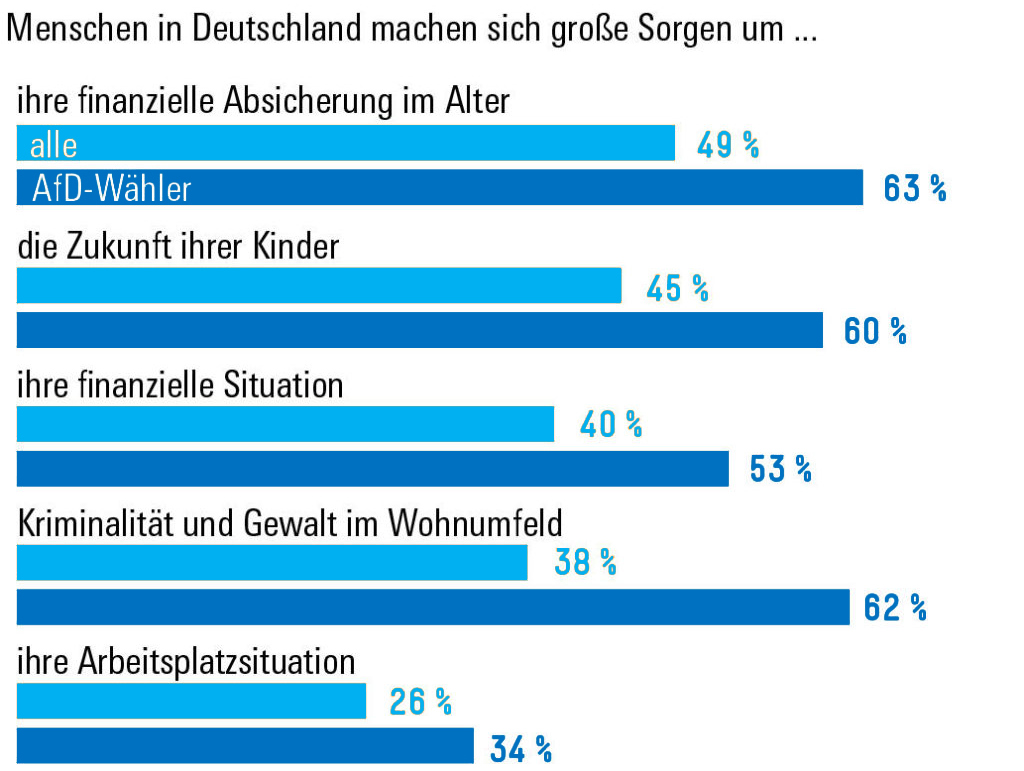
Source: Kohlrausch B. (2018).
The worries about relegation are more pronounced in the lower income brackets and decrease in the immediately higher income brackets; however, they then increase again in the upper income brackets and also underline the concern of a decline in status even in the higher income brackets.
Basically, however, critics of the study also note that in the long-term view, concerns about descent have decreased in the population as a whole.[6] In many surveys on socio-economic self-assessment questions, too, the majority always state that they are satisfied with both the objective and subjective economic situation. AfD supporters rate their situation as the lowest compared to the voters of other parties.
Fig. 6. Long-term concerns about the standard of living and social positioning in society (2017, in percent)
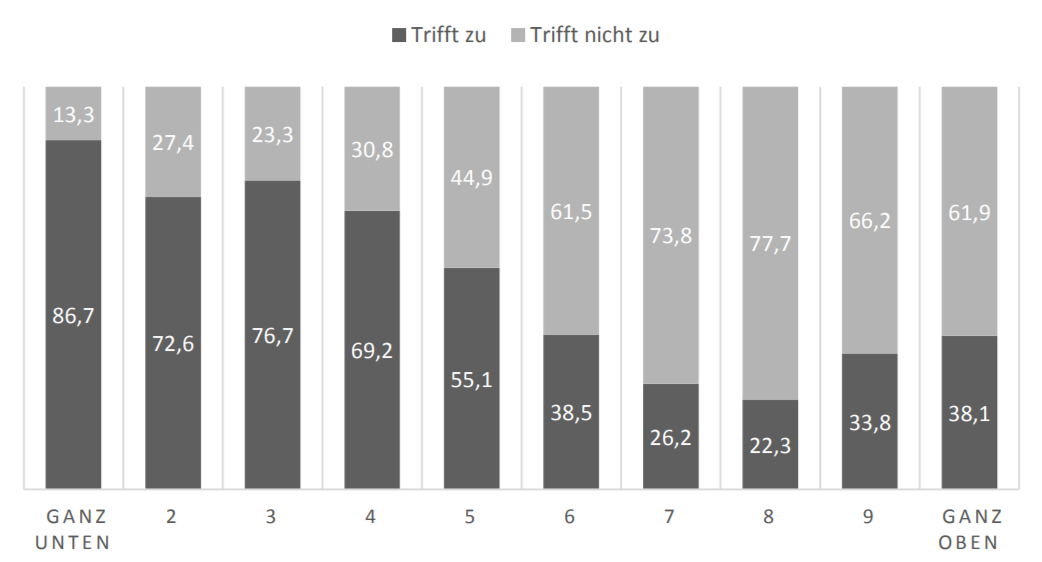
Source: Kohlrausch B. (2018).
Fig. 7. Self-assessment of social decline according to income (2017, in percent)
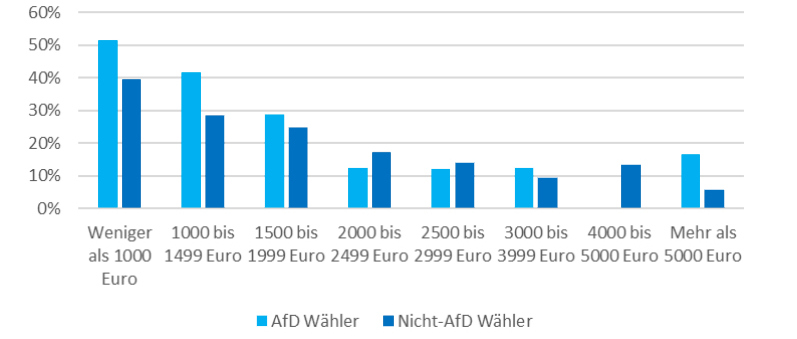
Source: Kohlrausch B. (2018).
In most of the surveys on the most important problems of AfD voters in Germany trends or the ZDF political barometer, the great concern of AfD voters is not about the immediacy or the presence of economic problems, but about the anticipation and prospect of future events and developments which can be described as a kind of loss of control in terms of employment history.
Fig. 8. Type of worries and fears about the future (2017, in percent)
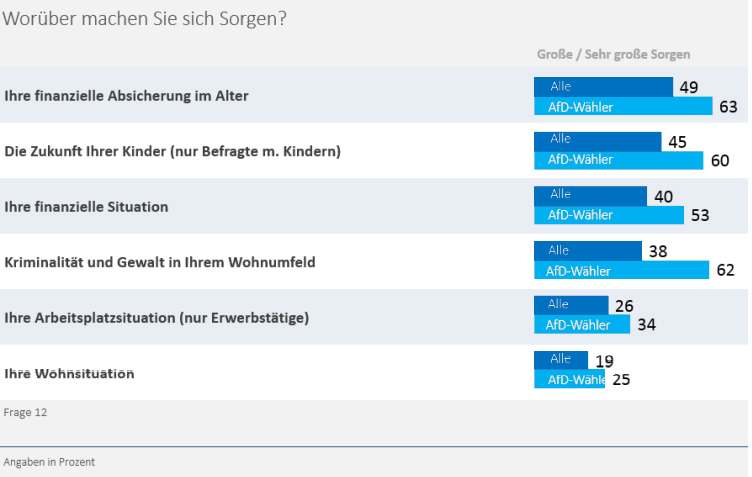
Source: Kohlrausch B. (2018).
Understanding the voting structure of the AfD is a mammoth task for pollsters and political analysts. In the economic dimension in particular, one often encounters supposed contradictions and inconsistencies. If one takes a closer look at the income distributions (divided into “decile” – 1 decile lowest income decile; 10 decile – highest income), the AfD electorate is more present in the lower income decile, weaker towards the middle and then again in the upper decile represented almost as strongly.[7]
Fig. 9. Voting decision according to income (2020, in percent)
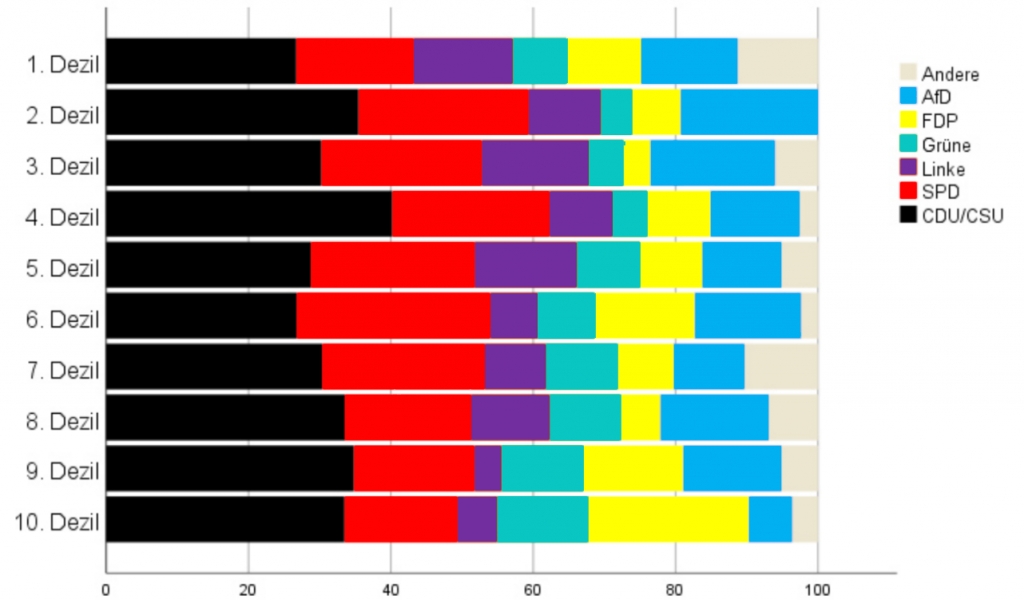
Source: Biskamp F. (2020).
When asked about personal financial attitudes towards life, the ambivalent thread continues within AfD sympathizers. On the one hand, many value a materially upscale lifestyle (see Bertelsmann study on the attitude patterns of different value environments within the corona pandemic) and also value material consumption and individual status.[8]
Fig. 10. Seven value milieus in Germany (2021)
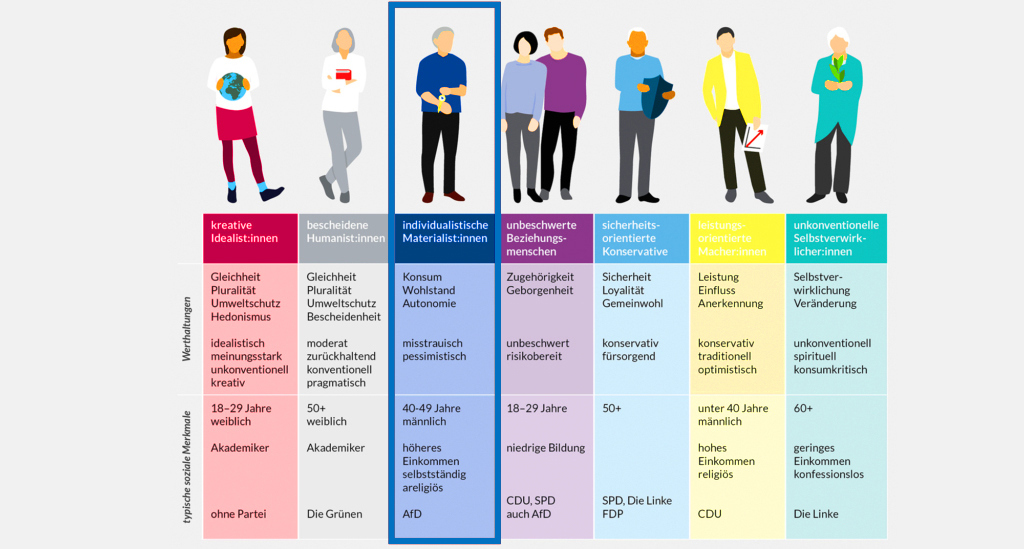
Source: Stephan Vopel S., El-Menouar Y. (2021).
On the other hand, studies such as the one by the Konrad-Adenauer-Stiftung on the “diversity of life of the electorate in Germany” show that AfD sympathizers are rarely able to afford a longer vacation. AfD voters seem to be following a traditionally conservative basic impulse, according to which maintaining one’s own status and long-term material goods are considered more important than an entertaining pleasure such as expensive vacation trips.[9]
Fig. 11. Lifestyle orientations by voting intent (2021, in percent)

Source: Roose (2021).
In the field of average income, other interesting factors can also be observed in AfD supporters, which once again suggest that dissatisfaction and concerns about relegation arise more from a precariousness of the immediate working conditions and the threatened loss of one’s own status position and less from a weak financial and income position. The “German Institute for Economics” (DIW) found in its study from 2017 that the AfD is on pair with the other parties with households with an average net income of 2,933 euros.[10] At the same time, however, the hourly and negotiated wages are significantly lower and even fall behind the average wage of the Left Party voters. This means that AfD voters usually have to work more hours or do several cheap jobs at the same time in order to maintain their standard of living. However, one must also take into account the possible distortion that not every income has to be made up of gainful employment.
Fig. 12. Average net income of households and employed persons by party preference (2017, in euros)
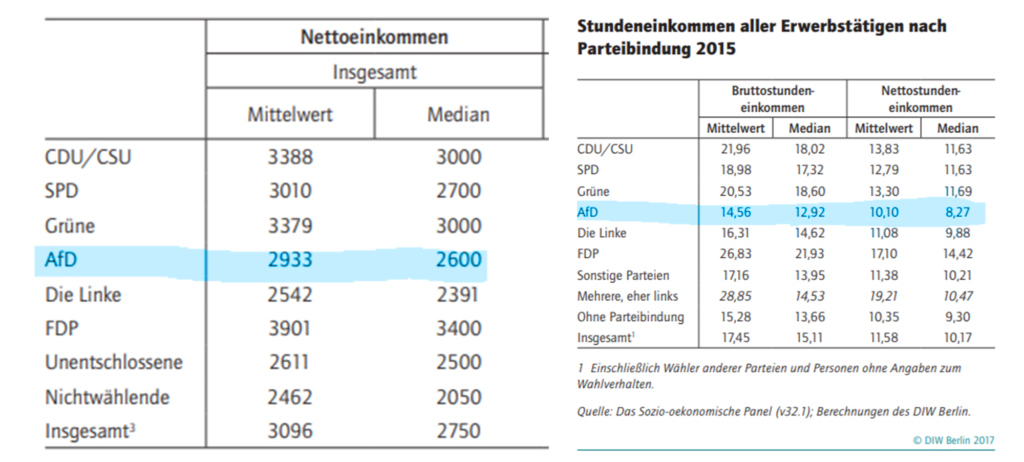
Source: Schröder M. (2018).
In a regional perspective, a few years ago the DIW examined demographic and geographical indicators based on constituency analyses that favour an election for the AfD.[11] In the macro dimension, the AfD has a classic German east-west division in the percentage approval values. However, the DIW has added other factors that may explain some of the successes in the West that may initially have less in common with the overall phenomenon in the East. For this purpose, a total of four cluster regions in east and west Germany were selected in which the AfD performed particularly well and applied the various socio-economic factors such as unemployment, proportion of foreigners, population density, average age, etc. and thus finally examined their deviations in the regions from one another. This makes it clear that the AfD does well in the west, in addition to social hot spots such as the Ruhr area, also in economically strong regions such as the southern German industrial cities and the rural regions of Eastern Bavaria. The authors of the study point to three central relationships.
Fig. 13. AfD election results, percentage deviations from the national average (2017, in percent)
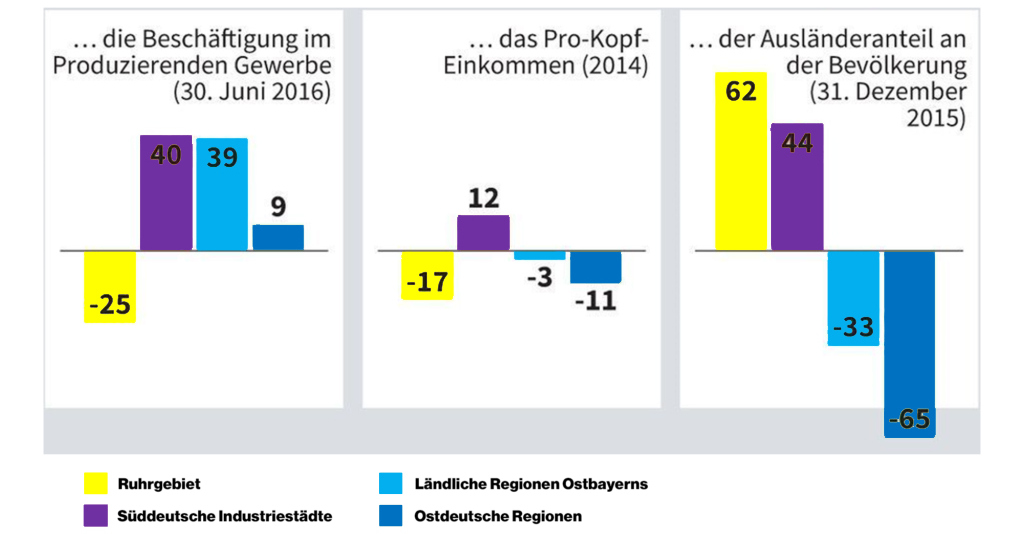
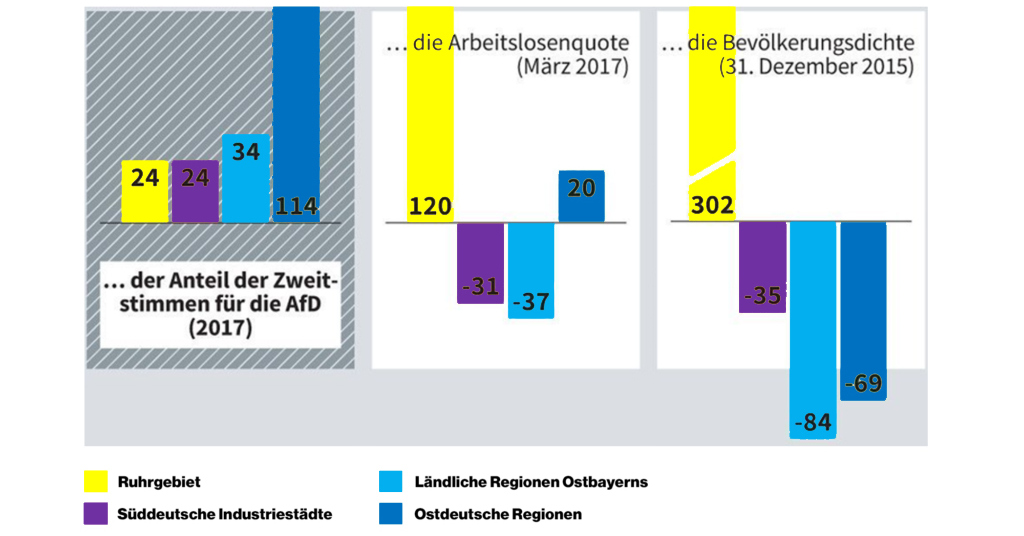
Source: Franz C., Fratzscher M., Kritikos A.S. (2018).
- The AfD is particularly strong in regions that are still characterized by a strong industrial sector or an above-average number of craft businesses.
- In East Germany, it is mainly demographically overaged districts with high levels of emigration and poorly developed infrastructure. The income structures show only a few correlations. In western German areas such as the Ruhr area, this looks a bit different, as the average income in the districts of western Germany sometimes diverges sharply.
The other variables examined, such as the proportion of foreigners or the unemployment rate, play a subordinate role due to the large differences in regional differences between individual western regions (high proportion of foreigners, less unemployment) and the east (low proportion of foreigners, high unemployment).
The urban-rural divide is also noticeable in the regional focus. In an article on konflikt Magazin that is well worth reading, the author Martin Scheliga examines the AfD results in the constituencies using several socio-economic variables.[12] For example, it becomes clear that Hartz IV recipients only have an increased affinity for the AfD if they also live away from the urban centres. In the large metropolitan regions, the result for Hartz IV recipients is mostly similarly high and, in some cases, even slightly below average compared to the total electorate in the respective region. Here, too, as in the DIW study, Scheliga comes to similar results in terms of average incomes. In the southwest, the AfD electorate is characterized by high incomes and in the east mostly by lower national average.
Conclusion and summary
Cultural conflict instead of a social question?
In order to understand the AfD target groups, it is not enough just to refer to their socio-economic class affiliation. In fragmented and flexible party systems and generally accelerated social dynamics, the economic explanatory foils can only be used as a supplementary analytical variable. The study situation in recent years points to a slight overhang of precarious and economically dependent milieus within the AfD electorate, but at the same time the psychological motivations are mostly decoupled from immediate material distribution conflicts and new social issue to be negotiated.
A deeper understanding may be obtained by looking at the cultural line of conflict between communitarians and cosmopolitans. This shows more clearly that the emergence and success of the AfD did not arise solely from a new social negotiation issue, but from an overall social climate that attacks the cornerstones of cultural identity and national sovereignty. The euro question in the year the AfD was created in 2013 was a catalyst because it was about the elementary question of self-determination and not about the financial details. In both the euro and the migration crisis, it was always about the renewal of fundamental questions of identity: Who are we? Why is it worth preserving what we have? Right-wing populism across Europe is thus also the mental countermovement of globalism, the large dimension of which sums up all the essential issues of the time – not just economic ones.
This means, as Benedikt Kaiser describes in his book “Solidarian Patriotism” that a social question from the right can only be supported by the nation-state and identity imperative.[13] The materialistic patterns of interpretation from the left – this is also shown by most studies – always come to the same results when they find that the AfD can hardly be won back with socio-political offers for the left-wing party spectrum. However, they are not prepared to counter the unleashed cultural dynamics in questions of immigration and political correctness. The “woke ideology”, multiculturalism and political correctness are now firmly anchored in left-wing DNA, leaving them politically impotent.
Neither the precariat nor the intellectual bourgeoisie
Almost all studies show that the AfD is not a clear milieu party. Regardless of which variable one looks at, whether unemployment, average income or occupation – the electorate usually remains very heterogeneous. There are certainly tendencies that point to a stronger preference in the lower social milieus, but which are cancelled out when the overall quantitative electorate is considered. But even looking at a supposedly conservative-intellectual bourgeoisie is unlikely to result in any significant electoral success on the basis of the available data. For the AfD, this means in the future, above all, to develop regionally specific concepts for addressing voters and to make nationwide campaigns accordingly more flexible.
Taking up relegation and loss concerns politically and empathically
With the rise of the AfD and other right-wing populist movements in Europe, one is probably experiencing a development that has not yet been recognized in its depth and fundamentality. Objective and rational explanatory models, as they mostly follow from socio-economic considerations, are not sufficient to understand the phenomenon in its entirety. The emotions and mental structures, as they can be recognized and expressed in the turning away from the elites, the concerns about relegation, the over-generational experiences and the anticipated fears about the future will require thorough processing and solid empirical foundations in the future, which can then be translated into political messages and content.
Fig. 14. Perception of problems among AfD supporters in comparison (2017, in percent)
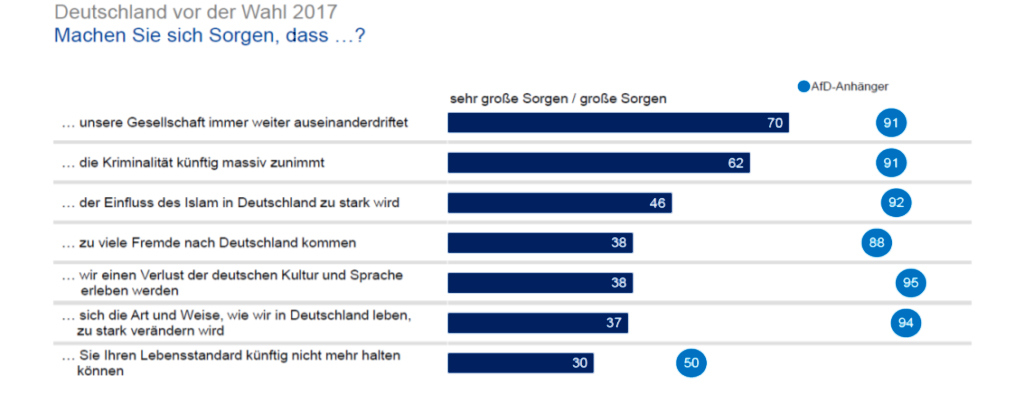
Source: ARD (2017).
One sees a great “illusion of prosperity” in many milieus, which gives people the sense of having secure work and a good income – for this reason, the majority of AfD voters are satisfied with their own economic situation – and at the same time through the employment histories run numerous breaks, uncertain employment relationships and the weakening of company solidarity networks as well as the certainty that the standard of living of the parents’ generation will be difficult to achieve. None of this is yet an exaggeration of a new class question, but it is a hint of a fundamental conflict of culture and values.
Notes
[1] Tarik Abou-Chadi T., Mitteregger R., Mudde C. (2021). Verlassen von der Arbeiterklasse? Die elektorale Krise der Sozialdemokratie und der Aufstieg der radikalen Rechten. FES. URL: http://library.fes.de/pdf-files/a-p-b/18075.pdf
[2] Lengfeld H., Dilger C. (2018). Kulturelle und ökonomische Bedrohung. Eine Analyse der Ursachen der Parteiidentifikation mit der „Alternative für Deutschland“ mit dem Sozio-oekonomischen Panel 2016. Zeitschrift für Soziologie. URL: https://www.degruyter.com/document/doi/10.1515/zfsoz-2018-1012/html
[3] Vehrkamp R., Wegschaider K. (2017). Populäre Wahlen. Mobilisierung und Gegenmobilisierung der sozialen Milieus bei der Bundestagswahl 2017. Bertelsmann Stiftung. URL: https://www.bertelsmann-stiftung.de/fileadmin/files/BSt/Publikationen/GrauePublikationen/ZD_Populaere_Wahlen_Bundestagswahl_2017_01.pdf
[4] Becker K. Dörre, Reif-Spirek P. (2020). Arbeiterbewegung von rechts? Ungleichheit – Verteilungskämpfe – populistische Revolte. bpb. URL: https://www.bpb.de/shop/buecher/schriftenreihe/318189/arbeiterbewegung-von-rechts
[5] Kohlrausch B. (2018). Abstiegsängste in Deutschland. Ausmaß und Ursachen in Zeiten des erstarkenden Rechtspopulismus. Hans-Böckler-Stiftung. URL: https://www.boeckler.de/pdf/p_fofoe_WP_058_2018.pdf
[6] Falkner T., Kahrs H. (2018). Deutungsmuster zum Erfolg der AfD bei der Bundestagswahl 2017. Rosa-Luxemburg-Stiftung. URL: http://www.horstkahrs.de/wp-content/uploads/2018/04/Falkner-Kahrs-2018-Literaturbericht-Deutungsmuster.pdf
[7] Biskamp F. (2020). Die Arbeiter_innen, der Autoritarismus und die AfD. Einige Daten aus Runde 9 des European Social Survey. URL: https://florisbiskamp.com/wordpress/wp-content/uploads/2020/02/Floris-Biskamp-Die-Arbeiter_innen-der-Autoritarismus-und-die-AfD.pdf
[8] Stephan Vopel S., El-Menouar Y. (2021). Zwischen individueller Freiheit und Gemeinwohl. Sieben Wertemilieus und ihre Sicht auf Corona. Bertelsmann Stiftung. URL: https://www.bertelsmann-stiftung.de/fileadmin/files/BSt/Publikationen/GrauePublikationen/Wertemilieus_2021_final.pdf
[9] Roose (2021). Lebensstilvielfalten vor der Bundestagswahl 2021. Eine repräsentative Umfrage zu
Lebensstilen und Wahlverhalten. KAS. URL: https://www.kas.de/de/einzeltitel/-/content/lebensstilvielfalten-vor-der-bundestagswahl-2021
[10] Schröder M. (2018). AfD-Unterstützer sind nicht abgehängt, sondern ausländerfeindlich. DIW. URL: https://www.diw.de/documents/publikationen/73/diw_01.c.595120.de/diw_sp0975.pdf
[11] Franz C., Fratzscher M., Kritikos A.S. (2018). German right-wing party AfD finds more support in rural areas with aging populations. DIW. URL: https://www.diw.de/documents/publikationen/73/diw_01.c.578785.de/dwr-18-07-1.pdf
[12] Scheliga M. (2021). Die Bundestagswahl (1) – Sozialpolitische Sicht. konflikt Magazin. URL: https://konfliktmag.de/die-bundestagswahl-1-sozialpolitische-sicht/
[13] Kaiser B. (2017). Solidarischer Patriotismus: Die soziale Frage von rechts. Verlag Antaios. Steigra.
*Translated and republished with kind permission from the original on Feldzug Blog /Okzident Media.
